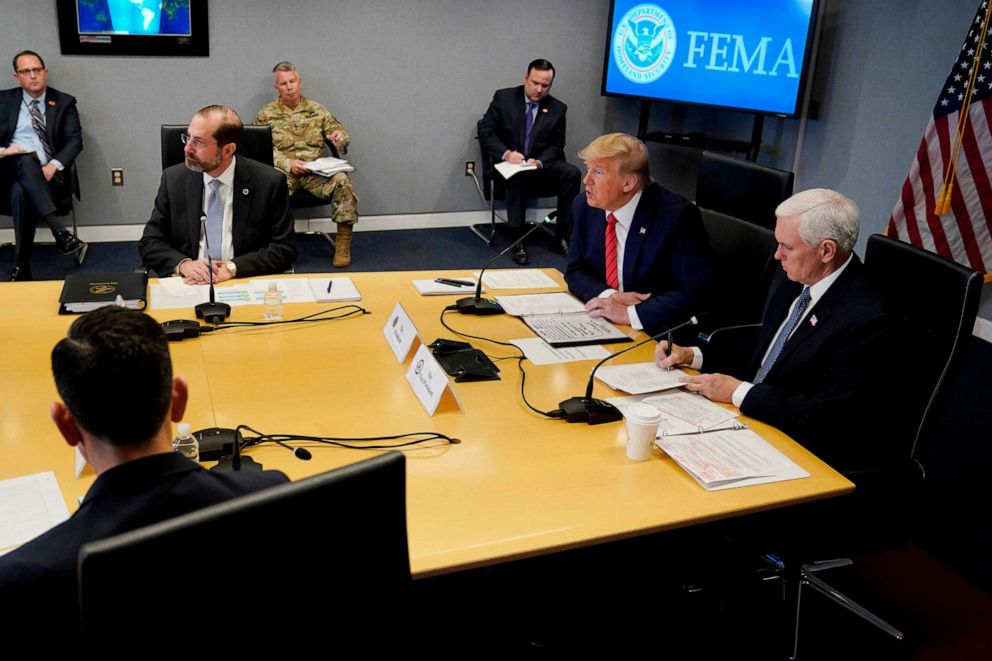FEMA faces multi-front battle on COVID-19 as hurricane season nears
FEMA facing multi-front war as hurricane season nears
The U.S. Federal Emergency Management Agency, in charge of the federal response to novel coronavirus, is now orchestrating one of the most complex response efforts in its history while also staring down a new upcoming season of wildfires and hurricanes.
The unprecedented undertaking raises serious questions about whether FEMA can meet both challenges and protect Americans vulnerable to disaster.
Experts say there might not be a choice.
“Is this ideal for FEMA? No,” said Brock Long, executive chairman of Hagerty Consulting and a former FEMA administrator. “FEMA is the only agency that has the capability of managing the unified incident command that’s currently taking place.”
FEMA is used to responding to wildfires, floods and hurricanes, but a public health emergency at the scale of COVID-19 is an unconventional challenge for the agency that could complicate the federal government’s response to future natural disasters.
“FEMA actually does deal with public health emergencies,” said Professor Trish Koman, a public health investigator at the University of Michigan and a former senior Environmental Protection Agency official. “They just stem from the physical impact of hurricanes or wildfires, but they are really dealing with it now whether they like it or not.”
Trying to expand capacity
FEMA quickly turned New York City's Jacob K. Javits Convention Center into a temporary field hospital, adding nearly 3,000 beds to help support the overwhelmed city hospitals.
In Chicago, FEMA worked with the National Guard and the U.S. Army Corps of Engineers to transform the city’s McCormick Place Convention Center into an alternate care facility for COVID-19 patients that don’t require intensive care. The convention center now boasts 1,750 rooms to help respond to future patients infected with the novel coronavirus.
“In addition to Chicago, under construction right now is the TCF center in Detroit,” said James Joseph, FEMA’s Midwest regional director. “The idea is to help support hospitals. There could be non-COVID patients or there could be COVID patients at these facilities.”
Chicago’s O’Hare International Airport has also been at the center of FEMA’s Project Airbridge, designed to transport medical supplies from FEMA chartered planes to onto third-party vehicles heading towards hospitals and other hard-hit areas.
While FEMA is responsible for coordinating the flow of medical supplies, it does not actually control the movement of those supplies. The task of actually distributing supplies has been left to private sector companies along with the nation’s largest transport carriers — UPS and FedEx.
“Our FEMA distribution centers have MREs, blankets and water, not the medical supplies,” said Lizzie Litzow, a FEMA spokesperson.
What did FEMA know and when?
FEMA, however, in July 2019 issued a warning with stunning accuracy about the perils of pandemic similar to the novel coronavirus. The report was drafted along with input from the White House Office of Science and Technology Policy and even warned about actions that would be needed to mitigate the effect, including social distancing.
ABC News' Martha Raddatz first asked FEMA administrator Pete Gaynor whether there was any warning about a coming pandemic.
"Is it really fair to say you had no warning about this?" Raddatz asked in a March 22 interview on This Week.
"The public health medical mission, statutory lies with HHS," Gaynor replied. "My mission, FEMA, prior to this was national disasters and those catastrophic events that happen."

But as the coronavirus rattles the world, governments everywhere are in a race to quickly procure critical medical supplies with a portion of supplies circulating within the U.S. heading for export overseas.
FEMA and CBP announced in a rare joint statement that they would work together to detain the domestic shipment of N95 respirators, surgical masks and gloves diverted for foreign export.
“COVID-19 has exposed the weakness of our supply chain infrastructure,” said Brock Long, executive chairman of Hagerty Consulting Group and a former FEMA administrator. “The private sector owns a majority of the infrastructure that we rely on.”
Preparing for the next disaster
The 2019 North Atlantic hurricane season had 18 named storms, six hurricanes, and three major hurricanes, according to NOAA, the agency responsible for monitoring major weather systems that could impact the U.S.
The first predictions for the 2020 hurricane season are expected from NOAA towards the end of May.
Around this time, FEMA would normally begin preparations for hurricane season. But the agency is deeply involved in addressing complaints from several state governors about supplies that haven’t arrived.
“A majority of the requests the governors are requesting from FEMA cannot be fulfilled because the materials don’t exist,” Long said. “We don’t need a bigger FEMA to overcome a pandemic next time, we need stronger infrastructure support.”
With just another month to the official start of hurricane season a little more than a month away FEMA officials are already trying to figure out what shelter in-place rules would look like in the event of a major hurricane or flooding situation.
“We are working with our partners on these efforts, including our new guidance on non-congregate sheltering to be able to support state and local efforts as they address these issues,” said a FEMA spokesperson.




